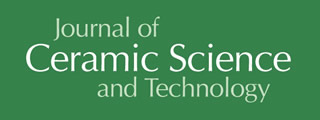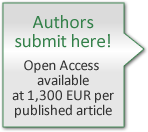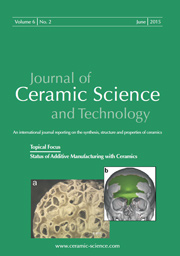Articles
All articles | Recent articles
Preparation and Characterization of Hydroxyapatite/Alumina Nanocomposites by High-Energy Vibratory Ball Milling
A. E. Hannora
Suez University, Faculty of Petroleum and Mining Engineering, Department of Science and Mathematics, Suez, Egypt, 43721.
received May 14, 2014, received in revised form July 3, 2014, accepted August 13, 2014
Vol. 5, No. 4, Pages 293-298 DOI: 10.4416/JCST2014-00019
Abstract
Hydroxyapatite/alpha-alumina composites were prepared by means of high-energy vibratory ball milling. The effect of the addition of alumina, from 5 to 25 wt%, was investigated. x-ray diffraction (XRD) and Fourier transform infrared spectroscopy (FT-IR) results indicated that hydroxyapatite and alumina were the major phases after mechanical milling and only small peak shifts were observed. Transmission electron microscope (TEM) photomicrographs revealed that the powder obtained after mechanical milling was composed of nanoparticles in the size of ∼ 40 nm. After 3h of air sintering at 1000 – 1200 °C, beta-tricalcium phosphate and alumina phases were found. The additional calcium aluminum phosphate phase might be formed during the sintering process at 1200 °C. The mechanical properties (compressive strength and Rockwell hardness) of the hydroxyapatite/alumina composites were improved with sintering temperatures and concentrations of alumina and the maximum value was found with 15 wt % alumina.
![]() Download Full Article (PDF)
Download Full Article (PDF)
Keywords
Mechanical alloying, hydroxyapatite, alumina and nanocomposite materials.
References
1 Rabiee, S.M., Moztarzadeh, F., Solati-Hashjin, M.: Synthesis and characterization of hydroxyapatite cement, J. Mol. Struct., 969, 172 – 175, (2010).
2 Kim, S.-J., Bang, H.-G., Song, J.-H., Park, S.-Y.:. Effect of additive on the mechanical properties of hydroxyapatite/alumina composites, Ceram. Int., 35, 1647 – 1650, (2009).
3 Mobasherpour, I., Solati Hashjin, M., Razavi Toosi, S.S., Darvishi Kamachali, R.: Effect of the addition ZrO2-Al2O3 on nanocrystalline hydroxyapatite bending strength and fracture toughness, Ceram. Int., 35, 1569 – 1574, (2009).
4 Wu, Z., He, L., Chen, Z.: Composite biocoating of hydroxyapatite/Al2O3 on titanium formed by al anodization and electrodeposition, Mater. Lett., 61, 2952 – 2955, (2007).
5 Jun, Y.-K., Kim, W.-H., Kweon, O.-K., Hong, S.-H..: The fabrication and biochemical evaluation of alumina reinforced calcium phosphate porous implants, Biomaterials, 24, 3731 – 3739, (2003).
6 Ayed, F.B., Bouaziz, J.: Sintering of tricalcium phosphate- composites by addition of alumina, Ceram. Int., 34, 1885 – 1892, (2008).
7 Kim, C.Y., Jee, S.S.: Hydroxyapatite formation on bioactive-glazed alumina, J. Eur. Ceram. Soc., 23, 1803 – 1811, (2003).
8 Chakraborty, J., Chatterjee, S., Sinha, M.K., Basu, D.: Effect of albumin on the growth characteristics of hydroxyapatite coatings on alumina substrates, J. Am. Ceram. Soc., 90, 3360 – 3363, (2007).
9 Chakraborty, J., Chatterjee, S., Sinha, M.K., Basu, D.: Effect of albumin on the growth characteristics of hydroxyapatite coatings on alumina substrates, J. Am. Ceram. Soc., 90, 3360 – 3363, (2007).
10 Chiba, A., Kimura, S., Raghukandan, K., Morizono, Y.: Effect of alumina addition on hydroxyapatite biocomposites fabricated by underwater-shock compaction, Mat. Sci. Eng. A, A350, 179/183, (2003).
11 Yelten, A., Yilmaz, S., Oktar, F.N.: Sol-gel derived alumina-hydroxyapatite-tricalcium phosphate porous composite powders, Ceram. Int., 38, 2659 – 2665, (2012).
12 Viswanath, B., Ravishankar, N.: Interfacial reactions in hydroxyapatite/alumina nanocomposites, Scripta Mater., 55, 863 – 866, (2006).
13 Evis, Z., Doremus, R.: Coatings of hydroxyapatite — nanosize alpha alumina composites on Ti-6Al-4V, Mater. Lett., 59, 3824 – 3827, (2005).
14 Fathi, M.H., Mohammadi Zahrani, E.: Fabrication and characterization of fluoridated hydroxyapatitenanopowders via mechanical alloying, J. Alloy. Compd., 475, 408 – 414, (2009).
15 Suryanarayana, C.: Mechanical alloying and milling, Prog. Mater. Sci., 46, [1 – 2], 1 – 184, (2001).
16 Hannora, A., Mamaeva, A.,Mansurov, Z.: X-ray investigation of Ti-doped hydroxyapatite coating by mechanical alloying, Surf. Rev. Lett., 16, [5], 781 – 786, (2009).
17 Hannora, A.E., Mukasyan, A.S., Mansurov, Z.A.: Nanocrystalline Hydroxyapatite/Si coating by mechanical alloying technique, Bioinorg. Chem. Appl., 390104, (2012).
18 Shih, W.J., Wang, J.W., Wang, M.C., Hon, M.H.: A study on the phase transformation of the nanosized hydroxyapatite synthesized by hydrolysis using in situ high temperature x-ray diffraction, Mater. Sci. Eng. C, 26, [8], 1434 – 1438, (2006).
19 Ebadzadeh, T., Behnamghader, A., Nemati, R.: Preparation of porous hydroxyapatite ceramics containing mullite by reaction sintering of clay, alumina and hydroxyapatite, Ceram. Int., 37, 2887 – 2889, (2011).
20 Ji, H., Marquis, P.M.: Sintering behaviour of hydroxyapatite reinforced with 20 wt% Al2O3, J. Mater. Sci., 28, 1941 – 1945, (1993).
21 Juang, H.Y., Hon, M.H.: Fabrication and mechanical properties of hydroxyapatite-alumina composites, Mater. Sci. Eng. C, 2.1 – 2, 77 – 81, (1994).
Copyright
Göller Verlag GmbH


